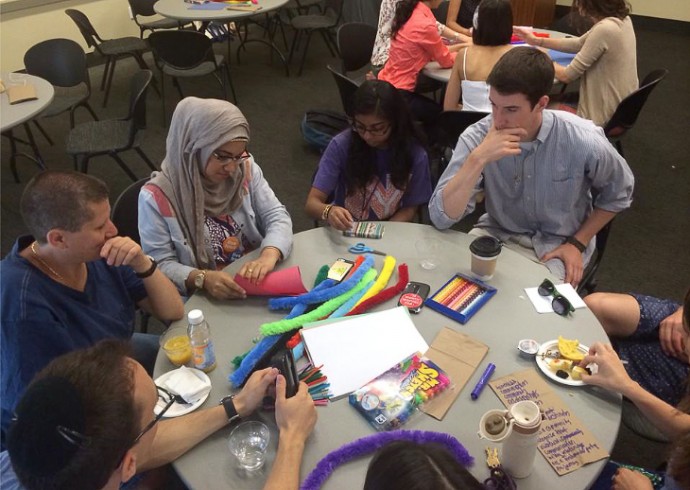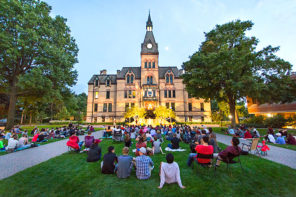An eye-catching building on the south side of Washington Square Park in New York City houses NYU’s Global Center for Academic and Spiritual Life. From a distance its walls seem covered in the tangled pattern of tree roots, giving the place an organic feel. This architectural embellishment symbolizes the naturalistic approach the Center promotes in its capacity as host to worship spaces of three historically disparate religious traditions.
Within its walls, an open-minded individual could spend a weekend dabbling in the spiritual worlds of Islam, Christianity and Judaism. A Friday night could include a trip to the Muslim prayer room via the Center’s ablution facilities on the fourth floor. The next day, the fifth floor of the Center offers NYU’s weekly Shabbat service. Finally, Sunday mornings, a Roman Catholic priest offers Holy Communion in the chapel on the ground floor.
Such a smorgasbord of organized religion is a tangible manifestation of the modern religious pluralistic ideal of “multifaith,” a term NYU has purposely adopted because of its emphasis on multiplicity. Where traditional “interfaith” might imply that dialogue can only exist between two religions at a time, the Center considers a collective religious discourse to be at the heart of the multifaith enterprise.
On the fourth floor, above the desk of Yael Shy, sits a small card with the word “understanding” in the striking calligraphy of Biblical Hebrew. Yael is the co-founder and director of NYU’s Center for Spiritual Life and runs the Center with the same spiritual inclusiveness she personally espouses. In a recent article for Inquiring Mind, Shy elaborates on her dual Jewish-Buddhist practice. “I often ask myself, ‘Is it possible to engage in a non-superficial way, in two rich spiritual traditions?’ So, far the answer is a resounding yes!” Yael sees a kind of universality in the wiring of the human brain whether the goal is Nirvana, some sort of beatific vision, or simply a sense of inner peace. This is the kind of understanding that the multi-faith enterprise at NYU endorses.
But this optimistic, common-core vision has incited debate, with some even questioning the sincerity of its progressive agenda, both on the NYU campus and well beyond.
On the one hand, the pure positivity of the multifaith enterprise appears as a battering ram to the barriers of difference that impede humanity’s collective progress. On the other, this optimism can seem misplaced and perhaps even delusional. Multifaith is attractive as a concept because hatred, suspicion and prejudice are so often bred out of a misconceived view of other religions: it surely makes sense to encourage inter-faith dialogue, the mingling of communities and collective understanding. But it is exactly this kind of thought process that has caused some to completely dismiss the multifaith ideal, saying that it grossly oversimplifies the issues truly at stake in these conflicts. At worst, it can serve as a PR tool of the dominant side to divert attention away from aspects of the conflict’s narrative that paint them in a negative light.
In a speech delivered in 2005 to a gathering of Belgian students, NYU’s President John Sexton articulated his vision of a “Second Axial Age,” a revelatory moment in humankind’s evolution in which the idea of the individual will be reconceptualized to “realize a fuller sense of common destiny and responsibility.” Organized religions are crucial to the realization of this vision for, in Sexton’s words, they must necessarily “bring themselves to the kind of openness to alternative conceptions of reality,” a requirement of the Second Axial Age. It’s the kind of openness that the Center’s programs seek to enshrine; an embodiment of the “ecumenical spirit,” as Sexton told me in email.
Above all else, this ecumenical spirit is about realizing the mutual insight and enrichment that true friendship can bring. In fact, a cornerstone of the part of the Center known as the Of Many Institute is the real life friendship of two of the university’s chaplains, Imam Khalid Latif and Rabbi Yehuda Sarna. The symbolic significance of such an inter-religious friendship was the subject of a film shown at this year’s Tribeca film festival titled simply “Of Many,” directed in house by Linda Mills, who is NYU’s Vice Chancellor for Global Programs and University Life and executive produced by Chelsea Clinton. Its tagline reads: ‘An Imam and a Rabbi: an unorthodox friendship.”
The film chronicles the lives of these two men as they bring together two disparate university communities, putting aside their outward differences to do disaster relief work in New Orleans in the aftermath of Hurricane Katrina. It illustrates the rhetoric of the multifaith enterprise as the friends create a communal understanding, transforming an atmosphere of potential enmity into a force of productive good.
This rhetoric is at the heart of NYU’s pioneering academic minor in Multifaith and Spiritual Leadership. Juliana Rordorf, a student in the program, told me she was attracted by the minor’s practical focus. One of her projects involved writing a hypothetical letter to New York’s Mayor Michael Bloomberg around the time of 9/11, advising him how best to broach the topic of the controversial Park51 project with his constituents. Her letter stressed the importance of viewing post 9/11 America as Judeo-Christian-Islamic as opposed to simply Judeo-Christian. Absolute inclusiveness should be the core value of a truly modern society. In NYU-speak, a society of the Second Axial Age.
At NYU last April, the university’s interfaith climate was tested over “Fliergate,” a move by students in NYU’s Students for Justice in Palestine to slide mock-eviction notices under the doors of students in the Palladium Hall dormitory. Their point was to raise awareness of the plight Palestinian people face under Israeli occupation of the West Bank. The protest caused a number of Jewish students living in the dorm to raise the spectre of anti-Semitism, saying publicly that the stunt made them feel victimized and unsafe.
There was fallout beyond the campus. A particularly vitriolic article appeared in the Times of Israel and a Brandeis University student appeared on Fox News to deride the Students for Justice in Palestine for perpetuating anti-Semitism. NYU responded by launching a process of “restorative justice.” John Beckman, the university spokesman, released the following statement outlining this process: “We will bring together the parties to work together under the direction of our Muslim and Jewish chaplains…to reverse the cycle from negative to affirmative exchanges.”
Multi-faith rhetoric pervades Beckman’s response, but Ellis Garey, a member of Students for Justice in Palestine, told me that she and many others in the organization found the university’s response to the incident confusing. Her primary qualm was that NYU decided to make the issue an interfaith one. Students for Justice in Palestine is not a faith-based organization. To make the issue about Muslim-Jewish relations on campus is to divert attention from the political issues that inspired the Palladium Hall protest.
Interestingly, a July article in Islamic Monthly criticized the general ethos underlying the multifaith or interfaith stance. The strongly worded piece attacked the Muslim Leadership Initiative, an Israeli interfaith program that invited a collection of American Muslim leaders to visit Israel to learn more about the prickly topic of Zionism. The writer, Sana Saeed, dismissed the program as an attempt at “faith-washing,” or the sanitizing of a particular conflict’s narrative in order to blur the line between the oppressed and oppressing parties involved. She argued that, by portraying the conflict over the West Bank as a “clash of civilizations,” Israel was attempting to divert attention from its occupational intent.
I brought up the student’s confusion and the notion of faith-washing in my conversation with Rabbi Yehuda. For him, it was important for Students for Justice in Palestine, in light of the controversy, to come out and affirm that their Palestinian advocacy was driven by entirely secular concerns. Their response, he said, “carves up a space in which Jews and Muslims can continue to collaborate without being under the fire of faith-washing.”
In other words, because the Students for Justice in Palestine are distancing themselves from any Islamic aspect of Palestinian support, the practical community-building productivity of the multi-faith enterprise can continue unblemished by the incident—it generates an on-campus environment in which inter-faith dialogue is clearly demarcated from any secular debate over the politics of a contentious issue such as the Israeli occupation.
In the case of Fliergate it is apparent that while the instigators were not religiously motivated, some of those on the receiving end interpreted it as so. The resulting confusion over the university’s response produced more misunderstanding than understanding for those in the two communities involved.
Abdullah Antepli, the Muslim chaplain at Duke University, in his response to Saeed’s piece in Islamic Monthly, spoke of his deep concern over “Muslims who are incapable of making a distinction between anti-Semitism and condemning the policies and the actions of the State of Israel”.
But perhaps we need to ask: shouldn’t the emphasis of this distinction be fundamental to the role of multifaith?





